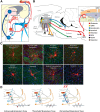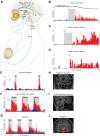Migraine: multiple processes, complex pathophysiology
- PMID: 25926442
- PMCID: PMC4412887
- DOI: 10.1523/JNEUROSCI.0373-15.2015
Migraine: multiple processes, complex pathophysiology
Abstract
Migraine is a common, multifactorial, disabling, recurrent, hereditary neurovascular headache disorder. It usually strikes sufferers a few times per year in childhood and then progresses to a few times per week in adulthood, particularly in females. Attacks often begin with warning signs (prodromes) and aura (transient focal neurological symptoms) whose origin is thought to involve the hypothalamus, brainstem, and cortex. Once the headache develops, it typically throbs, intensifies with an increase in intracranial pressure, and presents itself in association with nausea, vomiting, and abnormal sensitivity to light, noise, and smell. It can also be accompanied by abnormal skin sensitivity (allodynia) and muscle tenderness. Collectively, the symptoms that accompany migraine from the prodromal stage through the headache phase suggest that multiple neuronal systems function abnormally. As a consequence of the disease itself or its genetic underpinnings, the migraine brain is altered structurally and functionally. These molecular, anatomical, and functional abnormalities provide a neuronal substrate for an extreme sensitivity to fluctuations in homeostasis, a decreased ability to adapt, and the recurrence of headache. Advances in understanding the genetic predisposition to migraine, and the discovery of multiple susceptible gene variants (many of which encode proteins that participate in the regulation of glutamate neurotransmission and proper formation of synaptic plasticity) define the most compelling hypothesis for the generalized neuronal hyperexcitability and the anatomical alterations seen in the migraine brain. Regarding the headache pain itself, attempts to understand its unique qualities point to activation of the trigeminovascular pathway as a prerequisite for explaining why the pain is restricted to the head, often affecting the periorbital area and the eye, and intensifies when intracranial pressure increases.
Copyright © 2015 the authors 0270-6474/15/356619-11$15.00/0.
Figures



References
-
- Anttila V, Stefansson H, Kallela M, Todt U, Terwindt GM, Calafato MS, Nyholt DR, Dimas AS, Freilinger T, Müller-Myhsok B, Artto V, Inouye M, Alakurtti K, Kaunisto MA, Hämäläinen E, de Vries B, Stam AH, Weller CM, Heinze A, Heinze-Kuhn K, et al. Genome-wide association study of migraine implicates a common susceptibility variant on 8q22.1. Nat Genet. 2010;42:869–873. doi: 10.1038/ng.652. - DOI - PMC - PubMed
-
- Anttila V, Winsvold BS, Gormley P, Kurth T, Bettella F, McMahon G, Kallela M, Malik R, de Vries B, Terwindt G, Medland SE, Todt U, McArdle WL, Quaye L, Koiranen M, Ikram MA, Lehtimäki T, Stam AH, Ligthart L, Wedenoja J, et al. Genome-wide meta-analysis identifies new susceptibility loci for migraine. Nat Genet. 2013;45:912–917. doi: 10.1038/ng.2676. - DOI - PMC - PubMed
Publication types
MeSH terms
Grants and funding
- NS-069847/NS/NINDS NIH HHS/United States
- NS-079687/NS/NINDS NIH HHS/United States
- NS-064050/NS/NINDS NIH HHS/United States
- R01 NS069847/NS/NINDS NIH HHS/United States
- NS-056195/NS/NINDS NIH HHS/United States
- NS-073997/NS/NINDS NIH HHS/United States
- AT-007530/AT/NCCIH NIH HHS/United States
- R21 AT007530/AT/NCCIH NIH HHS/United States
- R37 NS079678/NS/NINDS NIH HHS/United States
- R01 NS073997/NS/NINDS NIH HHS/United States
- K24 NS064050/NS/NINDS NIH HHS/United States
- R01 NS056195/NS/NINDS NIH HHS/United States
LinkOut - more resources
Full Text Sources
Other Literature Sources
Medical
Research Materials
Miscellaneous
